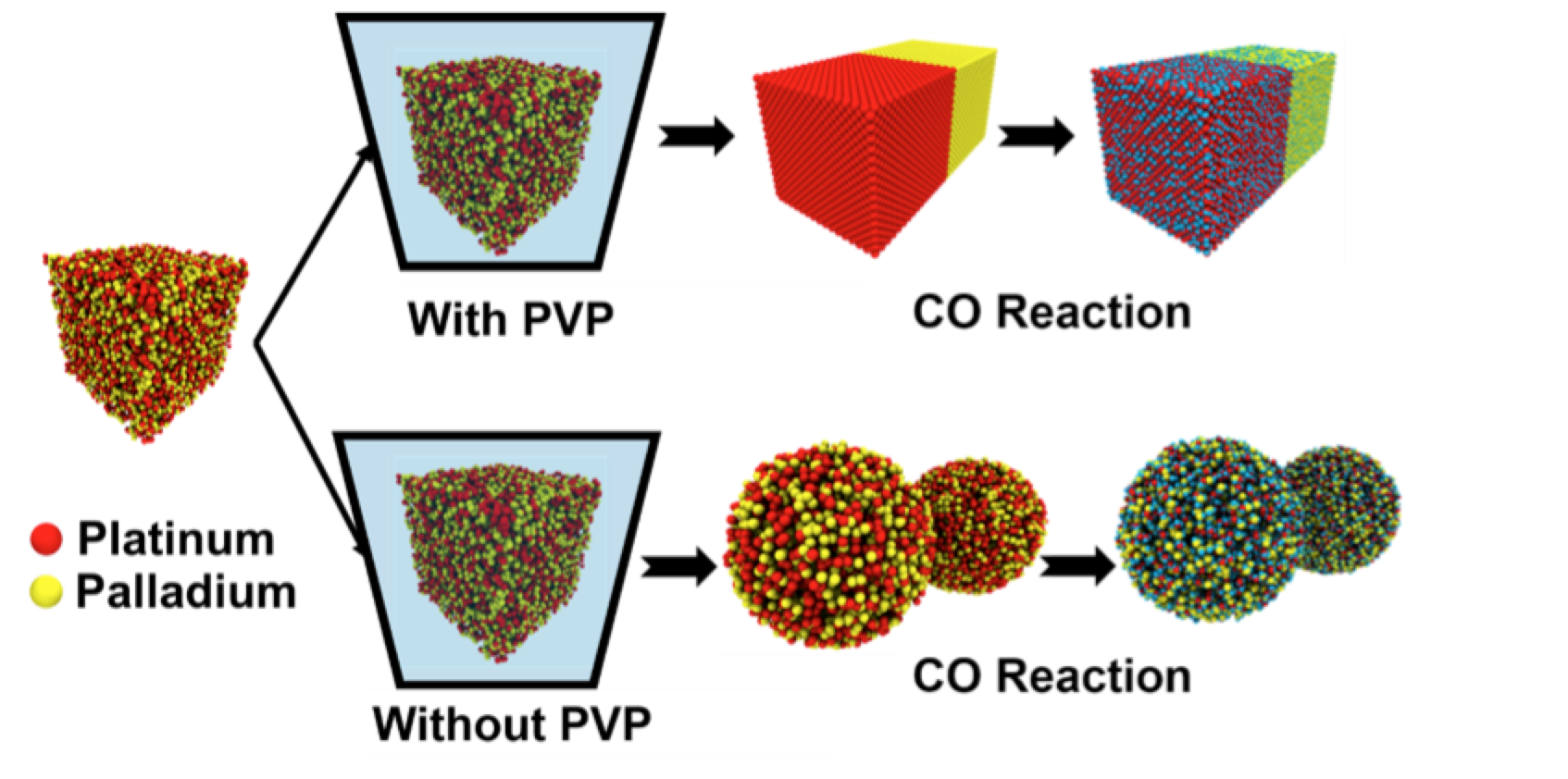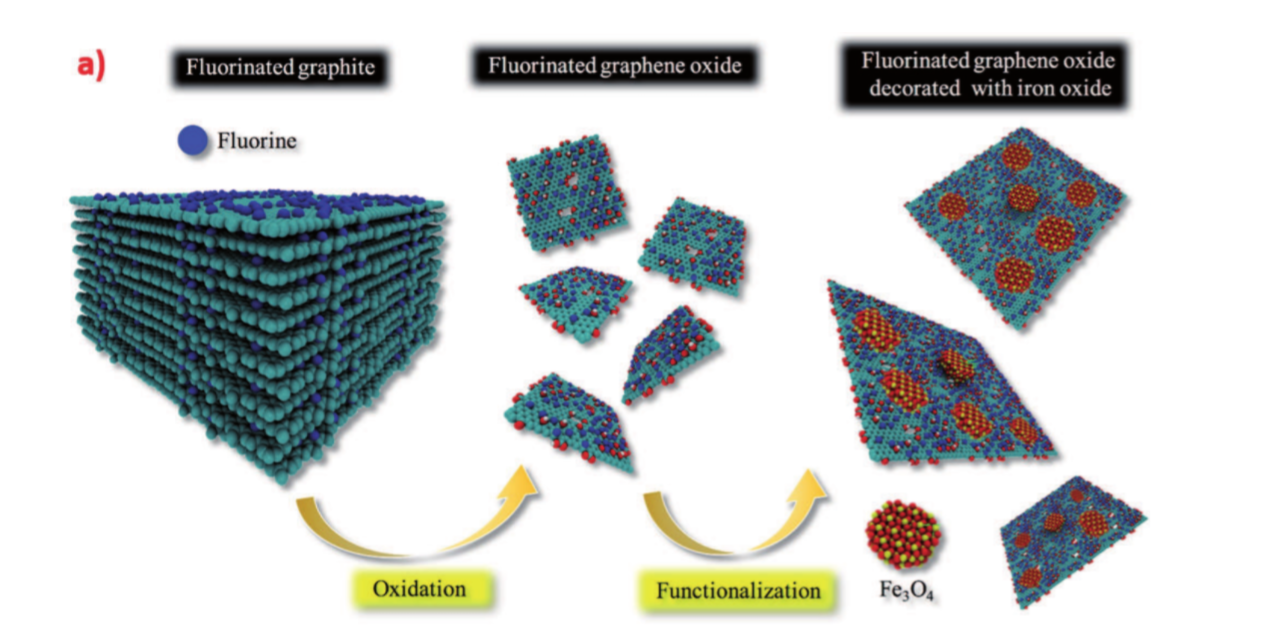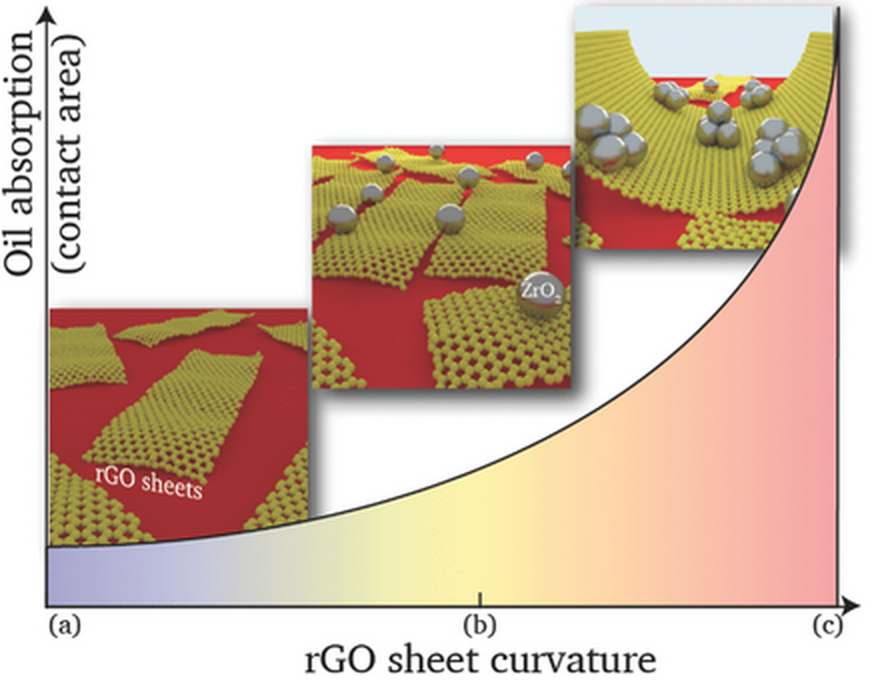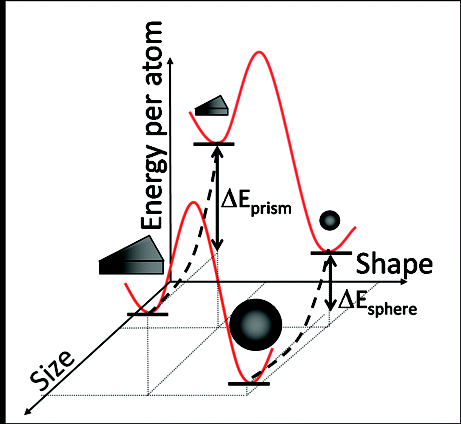Devi, M. Manolata; Dolai, N.; S, S. Sreehala; Jaques, Y. M.; Galvao, Douglas S.; C.S.Tiwary,; Sharma, Sudhanshu; Biswas, Krishanu
Morphology Controlled Graphene-Alloy Nanoparticles Hybrids with Tunable Catalytic Activity Journal Article
In: Nanoscale, vol. 10, pp. 8840-8850, 2018.
@article{Devi2018b,
title = {Morphology Controlled Graphene-Alloy Nanoparticles Hybrids with Tunable Catalytic Activity},
author = {M. Manolata Devi and N. Dolai and S. Sreehala S and Y. M. Jaques and Douglas S. Galvao and C.S.Tiwary and Sudhanshu Sharma and Krishanu Biswas},
url = {pubs.rsc.org/en/content/articlehtml/2018/nr/c7nr09688g},
doi = {10.1039/C7NR09688G},
year = {2018},
date = {2018-04-07},
journal = {Nanoscale},
volume = {10},
pages = {8840-8850},
abstract = {Selective oxidation of CO to CO2 using metallic or alloy nanoparticles as catalysts can solve two major problems of energy requirements and environmental pollution. Achieving 100% conversion efficiency at a lower temperature is a very important goal. This requires sustained efforts to design and develop novel supported catalysts containing alloy nanoparticles. In this regard, the decoration of nanoalloys with graphene, as a support for the catalyst, can provide a novel structure due to the synergic effect of the nanoalloys and graphene. Here, we demonstrate the effect of nano-PdPt (Palladium–Platinum) alloys having different morphologies on the catalytic efficiency for the selective oxidation of CO. Efforts were made to prepare different morphologies of PdPt alloy nanoparticles with the advantage of tuning the capping agent (PVP – polyvinyl pyrollidone) and decorating them on graphene sheets via the wet-chemical route. The catalytic activity of the G-PdPt hybrids with an urchin-like morphology has been found to be superior (higher % conversion at 135 °C lower) to that with a nanoflower morphology. The above experimental observations are further supported by molecular dynamics (MD) simulations.},
keywords = {},
pubstate = {published},
tppubtype = {article}
}
Parambath M Sudeep Sruthi Radhakrishnan, Jun Hyoung Park; Ajayan, Pulickel M
Multifunctional Hybrids Based on 2D Fluorinated Graphene Oxide and Superparamagnetic Iron Oxide Nanoparticles Journal Article
In: Particle & Particle Systems Characterization, vol. 34, no. 11, pp. 1700245, 2017.
@article{Radhakrishnan2017,
title = {Multifunctional Hybrids Based on 2D Fluorinated Graphene Oxide and Superparamagnetic Iron Oxide Nanoparticles},
author = {Sruthi Radhakrishnan, Parambath M Sudeep, Jun Hyoung Park, Cristiano F Woellner, Kierstein Maladonado, Douglas S Galvao, Benny Abraham Kaipparettu, Chandra Sekhar Tiwary, and Pulickel M Ajayan},
url = {http://onlinelibrary.wiley.com/doi/10.1002/ppsc.201700245/full},
doi = {DOI: 10.1002/ppsc.201700245},
year = {2017},
date = {2017-11-01},
journal = {Particle & Particle Systems Characterization},
volume = {34},
number = {11},
pages = {1700245},
abstract = {Carbon-based nanomaterials have garnered a lot of attention in the research of yesteryear. Here this study reports a composite based on fluorinated graphene oxide—a multifunctional subsidiary of graphene; and iron oxide nanoparticles as a contrast agent for magnetic resonance imaging (MRI). Extensive structural and functional characterization is carried out to understand composite behavior toward biotoxicity and its performance as a contrast agent. The electron withdrawing fluorine group decreases the charge transfer to iron oxide increasing the magnetic saturation of the composite thus enhancing the contrast. The interaction of paramagnetic and superparamagnetic systems yields a superior contrast agent for MRI and fluorescent imaging.},
keywords = {},
pubstate = {published},
tppubtype = {article}
}
Chandra Sekhar Tiwary Dibyendu Chakravarty, Leonardo Dantas Machado
Zirconia-Nanoparticle-Reinforced Morphology-Engineered Graphene-Based Foams Journal Article
In: Advanced Materials, vol. 27, no. 31, pp. 4534–4543, 2015.
@article{Chakravarty2015,
title = {Zirconia-Nanoparticle-Reinforced Morphology-Engineered Graphene-Based Foams},
author = { Dibyendu Chakravarty , Chandra Sekhar Tiwary , Leonardo Dantas Machado ,
Gustavo Brunetto , Soumya Vinod , Ram Manohar Yadav , Douglas S. Galvao ,
Shrikant V. Joshi , Govindan Sundararajan, Pulickel M. Ajayan },
url = {http://onlinelibrary.wiley.com/doi/10.1002/adma.201502409/full},
doi = {10.1002/adma.201502409},
year = {2015},
date = {2015-07-15},
journal = {Advanced Materials},
volume = {27},
number = {31},
pages = {4534–4543},
abstract = {The morphology of graphene-based foams can be engineered by reinforcing them with nanocrystalline zirconia, thus improving their oil-adsorption capacity; This can be observed experimentally and explained theoretically. Low zirconia fractions yield flaky microstructures where zirconia nanoparticles arrest propagating cracks. Higher zirconia concentrations possess a mesh-like interconnected structure where the degree of coiling is dependant on the local zirconia content.},
keywords = {},
pubstate = {published},
tppubtype = {article}
}
Rocha, Tulio CR; Sato, Fernando; Dantas, Socrates O; Galvao, Douglas S; Zanchet, Daniela
New Insights on the Growth of Anisotropic Nanoparticles from Total Energy Calculations Journal Article
In: The Journal of Physical Chemistry C, vol. 113, no. 28, pp. 11976–11979, 2009.
@article{rocha2009new,
title = {New Insights on the Growth of Anisotropic Nanoparticles from Total Energy Calculations},
author = {Rocha, Tulio CR and Sato, Fernando and Dantas, Socrates O and Galvao, Douglas S and Zanchet, Daniela},
url = {http://pubs.acs.org/doi/abs/10.1021/jp903794y},
year = {2009},
date = {2009-01-01},
journal = {The Journal of Physical Chemistry C},
volume = {113},
number = {28},
pages = {11976--11979},
publisher = {American Chemical Society},
abstract = {The growth mechanism of anisotropic metallic nanoparticles is still an open and polemical question. The common observation of the existence of nonspherical (not the most stable) shapes in varied experimental conditions is not fully understood. In this work, based on results from total energy calculations for different shapes and sizes of Ag nanoparticles, we provide new insights of why anisotropic structures are commonly found in different preparation conditions. We show that, assuming the presence of a particle shape distribution in the beginning of the growth process, anisotropic nanoparticles can preferentially grow over spherical ones due to the fact that the energy required to build larger anisotropic structures could be less than the one required to build isotropic structures. These results suggest that many previous works in literature shall be revisited accordingly to these new finds.},
keywords = {},
pubstate = {published},
tppubtype = {article}
}
2018

Devi, M. Manolata; Dolai, N.; S, S. Sreehala; Jaques, Y. M.; Galvao, Douglas S.; C.S.Tiwary,; Sharma, Sudhanshu; Biswas, Krishanu
Morphology Controlled Graphene-Alloy Nanoparticles Hybrids with Tunable Catalytic Activity Journal Article
In: Nanoscale, vol. 10, pp. 8840-8850, 2018.
Abstract | Links | BibTeX | Tags: alloys, Graphene, Modeling, Nanoparticles
@article{Devi2018b,
title = {Morphology Controlled Graphene-Alloy Nanoparticles Hybrids with Tunable Catalytic Activity},
author = {M. Manolata Devi and N. Dolai and S. Sreehala S and Y. M. Jaques and Douglas S. Galvao and C.S.Tiwary and Sudhanshu Sharma and Krishanu Biswas},
url = {pubs.rsc.org/en/content/articlehtml/2018/nr/c7nr09688g},
doi = {10.1039/C7NR09688G},
year = {2018},
date = {2018-04-07},
journal = {Nanoscale},
volume = {10},
pages = {8840-8850},
abstract = {Selective oxidation of CO to CO2 using metallic or alloy nanoparticles as catalysts can solve two major problems of energy requirements and environmental pollution. Achieving 100% conversion efficiency at a lower temperature is a very important goal. This requires sustained efforts to design and develop novel supported catalysts containing alloy nanoparticles. In this regard, the decoration of nanoalloys with graphene, as a support for the catalyst, can provide a novel structure due to the synergic effect of the nanoalloys and graphene. Here, we demonstrate the effect of nano-PdPt (Palladium–Platinum) alloys having different morphologies on the catalytic efficiency for the selective oxidation of CO. Efforts were made to prepare different morphologies of PdPt alloy nanoparticles with the advantage of tuning the capping agent (PVP – polyvinyl pyrollidone) and decorating them on graphene sheets via the wet-chemical route. The catalytic activity of the G-PdPt hybrids with an urchin-like morphology has been found to be superior (higher % conversion at 135 °C lower) to that with a nanoflower morphology. The above experimental observations are further supported by molecular dynamics (MD) simulations.},
keywords = {alloys, Graphene, Modeling, Nanoparticles},
pubstate = {published},
tppubtype = {article}
}
2017

Parambath M Sudeep Sruthi Radhakrishnan, Jun Hyoung Park; Ajayan, Pulickel M
Multifunctional Hybrids Based on 2D Fluorinated Graphene Oxide and Superparamagnetic Iron Oxide Nanoparticles Journal Article
In: Particle & Particle Systems Characterization, vol. 34, no. 11, pp. 1700245, 2017.
Abstract | Links | BibTeX | Tags: Modeling, Nanoparticles
@article{Radhakrishnan2017,
title = {Multifunctional Hybrids Based on 2D Fluorinated Graphene Oxide and Superparamagnetic Iron Oxide Nanoparticles},
author = {Sruthi Radhakrishnan, Parambath M Sudeep, Jun Hyoung Park, Cristiano F Woellner, Kierstein Maladonado, Douglas S Galvao, Benny Abraham Kaipparettu, Chandra Sekhar Tiwary, and Pulickel M Ajayan},
url = {http://onlinelibrary.wiley.com/doi/10.1002/ppsc.201700245/full},
doi = {DOI: 10.1002/ppsc.201700245},
year = {2017},
date = {2017-11-01},
journal = {Particle & Particle Systems Characterization},
volume = {34},
number = {11},
pages = {1700245},
abstract = {Carbon-based nanomaterials have garnered a lot of attention in the research of yesteryear. Here this study reports a composite based on fluorinated graphene oxide—a multifunctional subsidiary of graphene; and iron oxide nanoparticles as a contrast agent for magnetic resonance imaging (MRI). Extensive structural and functional characterization is carried out to understand composite behavior toward biotoxicity and its performance as a contrast agent. The electron withdrawing fluorine group decreases the charge transfer to iron oxide increasing the magnetic saturation of the composite thus enhancing the contrast. The interaction of paramagnetic and superparamagnetic systems yields a superior contrast agent for MRI and fluorescent imaging.},
keywords = {Modeling, Nanoparticles},
pubstate = {published},
tppubtype = {article}
}
2015

Chandra Sekhar Tiwary Dibyendu Chakravarty, Leonardo Dantas Machado
Zirconia-Nanoparticle-Reinforced Morphology-Engineered Graphene-Based Foams Journal Article
In: Advanced Materials, vol. 27, no. 31, pp. 4534–4543, 2015.
Abstract | Links | BibTeX | Tags: Electronic Structure, Mechanical Properties, Mole, Molecular Dynamics, Nanoparticles, Zirconia
@article{Chakravarty2015,
title = {Zirconia-Nanoparticle-Reinforced Morphology-Engineered Graphene-Based Foams},
author = { Dibyendu Chakravarty , Chandra Sekhar Tiwary , Leonardo Dantas Machado ,
Gustavo Brunetto , Soumya Vinod , Ram Manohar Yadav , Douglas S. Galvao ,
Shrikant V. Joshi , Govindan Sundararajan, Pulickel M. Ajayan },
url = {http://onlinelibrary.wiley.com/doi/10.1002/adma.201502409/full},
doi = {10.1002/adma.201502409},
year = {2015},
date = {2015-07-15},
journal = {Advanced Materials},
volume = {27},
number = {31},
pages = {4534–4543},
abstract = {The morphology of graphene-based foams can be engineered by reinforcing them with nanocrystalline zirconia, thus improving their oil-adsorption capacity; This can be observed experimentally and explained theoretically. Low zirconia fractions yield flaky microstructures where zirconia nanoparticles arrest propagating cracks. Higher zirconia concentrations possess a mesh-like interconnected structure where the degree of coiling is dependant on the local zirconia content.},
keywords = {Electronic Structure, Mechanical Properties, Mole, Molecular Dynamics, Nanoparticles, Zirconia},
pubstate = {published},
tppubtype = {article}
}
2009

Rocha, Tulio CR; Sato, Fernando; Dantas, Socrates O; Galvao, Douglas S; Zanchet, Daniela
New Insights on the Growth of Anisotropic Nanoparticles from Total Energy Calculations Journal Article
In: The Journal of Physical Chemistry C, vol. 113, no. 28, pp. 11976–11979, 2009.
Abstract | Links | BibTeX | Tags: growth, Nanoparticles, Structure
@article{rocha2009new,
title = {New Insights on the Growth of Anisotropic Nanoparticles from Total Energy Calculations},
author = {Rocha, Tulio CR and Sato, Fernando and Dantas, Socrates O and Galvao, Douglas S and Zanchet, Daniela},
url = {http://pubs.acs.org/doi/abs/10.1021/jp903794y},
year = {2009},
date = {2009-01-01},
journal = {The Journal of Physical Chemistry C},
volume = {113},
number = {28},
pages = {11976--11979},
publisher = {American Chemical Society},
abstract = {The growth mechanism of anisotropic metallic nanoparticles is still an open and polemical question. The common observation of the existence of nonspherical (not the most stable) shapes in varied experimental conditions is not fully understood. In this work, based on results from total energy calculations for different shapes and sizes of Ag nanoparticles, we provide new insights of why anisotropic structures are commonly found in different preparation conditions. We show that, assuming the presence of a particle shape distribution in the beginning of the growth process, anisotropic nanoparticles can preferentially grow over spherical ones due to the fact that the energy required to build larger anisotropic structures could be less than the one required to build isotropic structures. These results suggest that many previous works in literature shall be revisited accordingly to these new finds.},
keywords = {growth, Nanoparticles, Structure},
pubstate = {published},
tppubtype = {article}
}
http://scholar.google.com/citations?hl=en&user=95SvbM8AAAAJ


